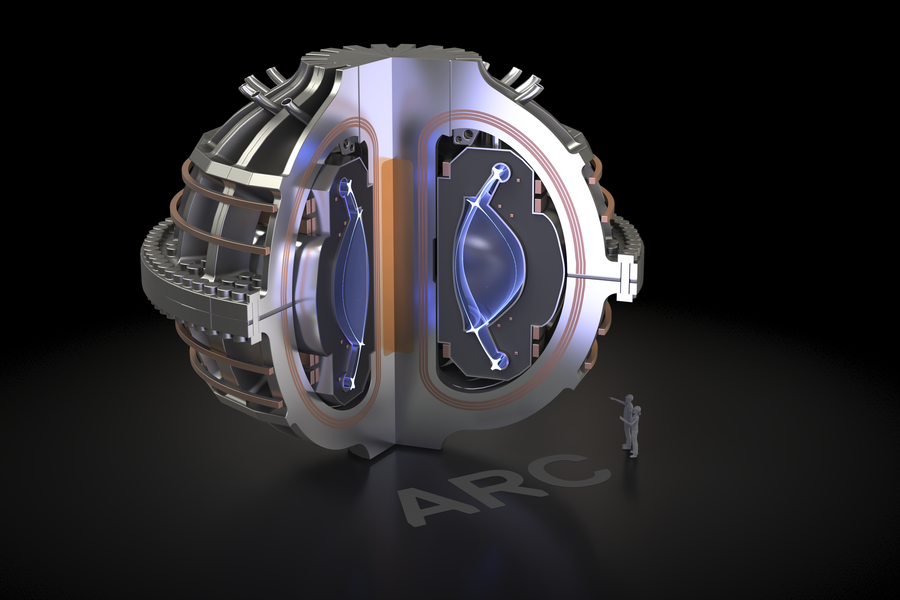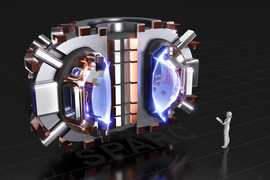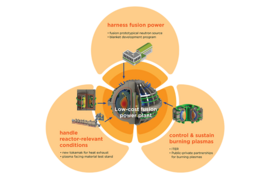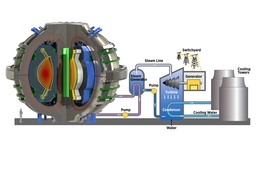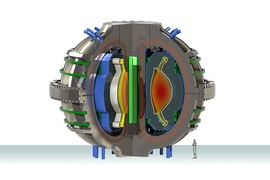Electricity generated by fusion power plants could play an important role in decarbonizing the U.S. energy sector by mid-century, says a new consensus study report from the National Academies of Sciences, Engineering, and Medicine, which also lays out for the first time a set of technical, economic, and regulatory standards and a timeline for a U.S. fusion pilot plant that would begin producing energy in the 2035-40 time frame.
To achieve this key step toward commercialization, the report calls for an aggressive public-private effort to produce by 2028 a pilot plant design that can, when built, accommodate any of the developmental approaches seeking to realize fusion’s potential as a safe, carbon-free, on-demand energy source.
These include what it calls the “leading fusion concept, a deuterium-tritium fueled tokamak,” like that being pursued at MIT spinout Commonwealth Fusion Systems (CFS) with support from the Institute’s Plasma Science and Fusion Center (PSFC) and Department of Nuclear Science and Engineering. Martin Greenwald, deputy director of the PSFC, notes that “the report can be seen as confirming and validating the vision that motivated the founding of CFS in 2018.” The new report follows and extends a 2018 National Academies study that (while acknowledging the significant scientific and technical challenges still faced by fusion) saw promise in the tokamak approach, called for continued U.S. participation in the international ITER fusion experiment, and suggested a pilot plant effort .
PSFC director and Hitachi America Professor of Engineering Dennis Whyte helped develop the new study as a member of the National Academies’ Committee on the Key Goals and Innovation Needed for a U.S. Fusion Pilot Plant, which also included representatives from other universities, national laboratories, and private companies. It sought out a broad range of expertise from government, academic, and private-sector sources, including U.S. utilities and energy companies.
“The biggest thing,” says Whyte, is that the diverse group “came to a consensus that fusion is relevant, and that this effort is important.” Driving factors include utility industry commitments to deep cuts in carbon emissions in coming decades, along with a combination of simultaneous synergistic advances in fusion science and technology, application of new resources from areas outside the traditional fusion community, and particularly the rise of interest in private fusion developers like CFS, which collectively have received some $2 billion in funding in recent years.
There has also been a broad pivot by much of the nation’s fusion research community away from a focus on science and toward a mission of practical energy production. This consensus was expressed in a recent report by the Federal Energy Sciences Advisory Committee (FESAC) that urged the nation to “move aggressively toward the deployment of fusion energy, which could substantially power modern society while mitigating climate change,” and suggested development of a pilot plant. The new National Academies study advances the concept with specifics on what a successful pilot plant would look like.
The report’s authors took a marketplace-driven approach to defining the pilot plant’s characteristics, based on discussions with utilities and other energy-sector organizations that would ultimately be the builders, owners, and operators of fusion generating facilities, says Whyte. “Setting those goal posts is very important, laying out the technical, regulatory, and economic performance requirements for the pilot plant,” he explains. “They’re demanding, but they should be, because that’s what’s needed to make fusion viable.”
Those requirements include a total pilot plant cost of less than $5-6 billion and generating capacity of at least 50 megawatts. In addition to proving the ability to create reliable, sustained net energy gain and power production from fusion for steadily increasing periods of time, says the report, the plant must provide “cost certainty to the marketplace in terms of capital cost, construction time, control of radioactive effluents including tritium, the cost of electricity, and the maintenance/operating schedule and cost.”
These results would inform subsequent construction of first-of-a-kind commercial fusion plants in the 2040s, and then broader propagation of fusion energy facilities onto the grid around mid-century, by which time major U.S. utilities have committed to deep reductions in their carbon emissions.
A key near-term factor in achieving these goals is formation of multiple public-private teams to conceptualize and design aspects of the pilot plant over the next seven years. These include improved fusion confinement and control, materials that can withstand the withering temperatures and stresses produced during fusion, methods of extracting fusion-generated heat and harnessing it for generation, and development of a closed fuel cycle. All are technically challenging and also require close attention to cost, manufacturability, maintainability, and other system-level considerations.
Combining resources from national labs, academic institutions, and private industry is a good approach to addressing these tasks, says Martin Greenwald, deputy director of the PSFC and senior research scientist. “Technologies like fusion come to market through the private sector, especially in the U.S., and once you understand that you can see appropriate roles for government labs that can do basic research, universities that are free to work with private industry, and companies that can use their own capital to pick up and commercialize the work.” Private space programs provide an example, he notes, with companies building rockets and using NASA facilities for things like testing and launch.
“The question,” adds Greenwald, “is whether we can collectively gather the resources and investments and execute in a way that meets the pace. We don’t want to be complacent about how audacious this is, but we have to be audacious if we’re going to meet the need.”
Bob Mumgaard, chief executive officer of CFS, says the new report is another indication of fusion’s growing momentum. In addition to the two National Academies studies, growing private investment, and FESAC’s community-driven recommendations, he points to the January enactment of federal appropriations legislation that funded both domestic and international fusion activities, including ongoing participation in ITER.
“For first time in 40 years, the U.S. government has a policy of building a new energy industry, a whole ecosystem,” says Mumgaard. “The legislation sort of pre-authorized many of the things the National Academies report says are good ideas, like the pivot into energy technology, the more-aggressive timeline, and getting regulation sorted out, which is going pretty well, actually — that’s all in the bill. It lays the groundwork for the broad community to take all this to heart and start doing the work. It’s very different from isolated companies doing their own thing, and universities running experiments, and has been very rapid in terms of how these things usually go. We are entering a whole new era for fusion.”
Cecil and Ida Green Professor Emeritus Ernest Moniz, who served as U.S. secretary of energy during the Obama administration, adds that “The academy report alerts the scientific community, the Congress, and the Biden Administration, which is prioritizing climate change risk mitigation, to the incredible progress over the last years towards fusion as a viable energy source — innovation along several technology pathways, supported largely by private capital. Public-private partnerships can help take several of these technologies to demonstrations in this decade, allowing fusion to be a critical enabler of a decarbonized electric grid before mid-century.”
